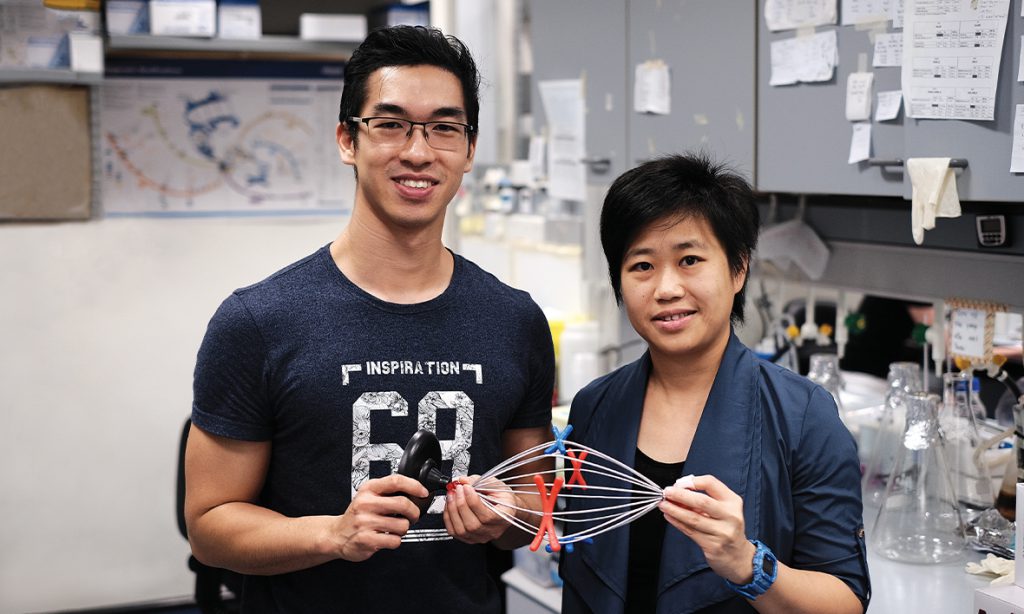November 2019 | Volume 21 No. 1
Chromosome Stability in the Balance
The groundbreaking research, which revealed that centromeric DNA is used as a template to produce a non-protein coding centromeric RNA essential for chromosome stability, was done by Associate Professor Dr Karen Wing Yee Yuen, who heads HKU’s Chromosome Biology Laboratory, and Post-doctoral Fellow Dr Yick Hin Ling, both from the School of Biological Sciences.
“During cell division, the cell must distribute its chromosomes equally and accurately to its daughter cells,” said Dr Ling, first author of the work. “Errors occurring in chromosome segregation can result in cells with an abnormal number of chromosomes, called aneuploidy, which is a hallmark of cancers and may also cause spontaneous abortion or birth defects. Therefore, it is important to understand the regulation of cell division.
“Centromere is one of the major elements on a chromosome to regulate the movement of the chromosome during cell division. Our research suggests that mis-regulation of cenRNA [centromeric ribonucleic acid] expression causes centromere malfunction, which results in chromosome instability and aneuploidy.”
Their discovery has sparked much interest in scientific circles, partly because non-coding RNA produced from the centromere (cenRNA) has really captured scientists’ attention over the last decade. As cenRNA is present in a very small amount, whether it has meaningful biological functions, or it is simply useless, has been a matter of frequent debate.
“Our study has two main discoveries,” explained Dr Ling. “First, cenRNA controls the cell division of budding yeast, one of the simplest forms of eukaryotes in the earth. In recent literature, we know that cenRNA also controls the cell division in animals like mice and humans. Therefore, our findings suggest that the action of cenRNA in cell division remains unchanged throughout evolution.
“Second, our work showed that the cenRNA level is tightly regulated. Too much or too little cenRNA affects the stability of the chromosome. It is clear that the cells produce only a minute amount of cenRNA for a reason. In future research, we are very interested in studying the mechanism behind this.”

Dr Yick Hin Ling (left) and Dr Karen Yuen (right) from the School of Biological Sciences show that too many or too little cenRNA [centromeric ribonucleic acid] will result in cell division error.
Implications for cancer research
Recent studies have shown a link between a high level of cenRNA and breast cancer. In mice, breast cancer can be induced by artificial overexpression of cenRNA in the cells of mammary glands.
“The mechanism is unclear, but we think that a high cenRNA level will disrupt the normal function of the centromere, causing aneuploidy and driving cancer formation,” said Dr Ling. “Another study indicated that high cenRNA levels may also promote the formation of an extra centromere on the chromosome. When a chromosome contains two centromeres, it will break during cell division, resulting in chromosome fusion, rearrangement and breakage again, common in tumour cells.”
The research team now intends to see if cenRNA can be used as a biomarker in disease diagnosis and/or as a target for cancer therapy. Dr Ling said: “Our first step will be to gain a more thorough understanding of the action of cenRNA spatially and temporally, and how the cenRNA expression is mis-regulated, causing chromosome instability, aneuploidy, and eventually cancer.“
Path to discovery
The Chromosome Biology Laboratory began focussing on the regulation of the centromere in 2011 under Dr Yuen’s stewardship. When Dr Ling joined the laboratory in 2013, they began to investigate how cenRNA regulates the yeast centromere.
During her PhD, Dr Yuen identified hundreds of genes that would cause chromosome instability in yeast. These genes included human gene homologs with relevance to cancer. “We are excited to see multiple genes that cause cenRNA mis-regulation. We may be able to find a cenRNA-related mechanism that underlines cancer development,” she said.
“In humans, there are 23 pairs of chromosomes, and yeast has 16. So in the project, we are actually dealing with 16 different species of cenRNAs. We tried to deplete one particular species of cenRNAs to see what happened to the chromosome from which the cenRNA originated. We found that the chromosome is perfectly fine. That was the moment that we both thought that cenRNA was useless.”
Fortunately, however, they did not stop there: Dr Ling spent a year doing complicated yeast genetics to deplete all 16 species of cenRNAs. “We found that the chromosome is unstable only when we manipulate all the cenRNA species,” he said. “We also found a sweet spot of cenRNA level for a chromosome to function normally. Both too much and too little cenRNA are detrimental.”
Baker’s yeast, or budding yeast shares 23 per cent of human genes, meaning that yeast is an excellent model organism for studying basic biological processes in which yeast and humans shared, such as cell division and DNA replication.
“Yeasts are fast and easy to grow, and we can manipulate their DNAs quite easily, which allows us to do experiments that are difficult to do in humans or mammalians,” said Dr Ling.
“We often get our first understanding of fundamental conserved human cell processes via experiments on yeast.”
Dr Yuen added: “With simple model organisms like yeast, you can find out the most basic mechanism of how eukaryotic cells work, accurately and efficiently. We can learn a lot about ourselves from these single-cell organisms, with our creativity and imagination in experimental design.
“What comes next is that we’ll visualise the localisation dynamics of such cenRNA in live cells within their two-hour cell cycle, and understand their functions using different ‘guilt by association’ approaches.”
We are excited to see multiple genes that cause cenRNA [centromeric ribonucleic acid] mis-regulation. We may be able to find a cenRNA-related mechanism that underlines cancer development.

DR KAREN YUEN

